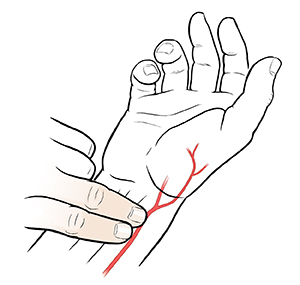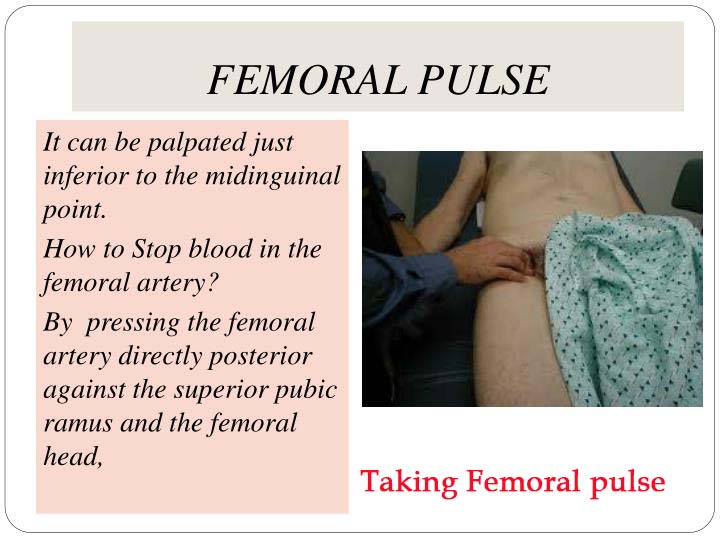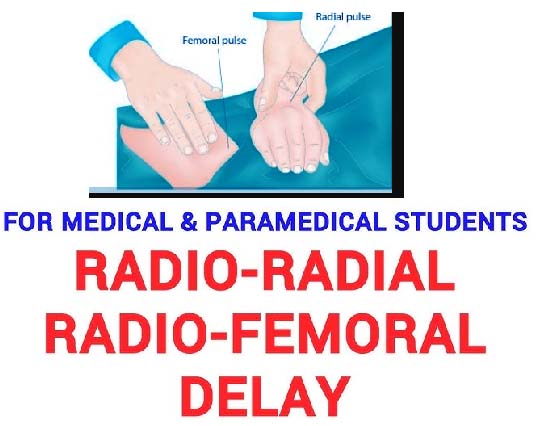Radiofemoral delay is one of the bedside diagnostic tools for assessing different vessel diseases in an easy way. It’s a very simple way to do it. Doing radiofemoral delay examination is essential to find different following conditions.
Radiofemoral delay aortic dissection, thromboembolism, atherosclerosis of the aorta, and Coarctation of the aorta
What is Radiofemoral Delay?
Radiofemoral delay is the way of finding the delay of the radial and femoral pulse. Normally the pulse of the femoral and the radial artery occur simultaneously.
When there are the femoral pulse lags behind the radial (radio-femoral delay) then it can be said that there is a problem with the occlusion in the aorta which might due to different reasons. Mostly if there is radiofemoral delay in atherosclerosis patients, we should check for the radio femoral delay in all the hypertensive patients as well
Let me know more about how to palpate the radial pulse and femoral pulse at first.
How to Palpate Radial Pulse?
Most of us know about palpating radial pulse. It’s not so much difficult. The radial pulse is palpated and located on the lateral side of the wrist in the anatomical snuffbox. It is the pulsation of the radial artery. Radial pulse can be taken on both wrists in the following ways
Steps to palpate Radial Pulse
- Make your palm up
- Put the tip of the index and middle finger of your hand between your wrist bone and on the thumb
- Apply gentle pressure over there. No need to push too hard
- Pulse beat can be felt
You can count the beat as the pulse rate and the rhythm. It should be regular. If irregular, then it might be a condition of some diseases as well.
How to Palpate the Femoral Pulse?
The femoral pulse is the pulsation of the femoral artery. It is located in the inguinal region either on right or left of the inner thigh. It is well palpated in the mid-inguinal point which is halfway between the anterior superior iliac spine and the pubic symphysis
When there is a decrease or absence of the femoral pulses, it may be an indication of occlusion of proximal peripheral vessels so it is mostly seen in peripheral vascular disease.

Steps to Palpate Femoral Pulse
- The patient should be in the supine position.
- Slightly abduct the thigh.
- Make sure to know the position of the inguinal ligament
- Below the inguinal ligament and in midway between the symphysis pubis and anterior superior iliac spine press deeply with the index and middle fingertip
- Now you will be able to feel the pulsation of the femoral artery.

Femoral pulse rate, volume strength, and timing can be recorded for diagnosing different conditions.
How to Find Radiofemoral Delay?
To find the radio-femoral delay, you should do palpation of the radial and femoral arteries simultaneously. There is a simultaneous pulsation of radial and femoral arteries. If there is a significant delay in the femoral pulse compared to the radial pulse, then we call it radiofemoral delay.
In normal health conditions, there is no radio-femoral delay. These are the times at which the pulse arrives after cardiac contraction (cardiac systole)
- Carotid arteryà30ms
- Brachial arteryà 60ms
- Radial arteryà80ms
- Femoral arteryà 75ms
When there is a delay of arrival of the pulsation in the radial and femoral artery then we should find out the causes for it.
radiofemoral delay causes
Radiofemoral delay can be due to different causes. When normal there is no delay. The following are the causes of radiofemoral delay.
1. Atherosclerosis of the aorta.
Atherosclerosis is the formation of plaque over the blood vessels. When there is the formation of plaque over the aorta it is called atherosclerosis of the aorta. It can be in either the thoracic or abdominal aorta.
This is one of the occlusive aortic diseases caused by atherosclerosis which is confined to the distal part of the abdominal aorta below the origin of renal arteries.
Most of this disease extends to the iliac arteries as well.
Claudication and pain involve the buttocks, thighs, and calf muscles, and it may be associated with impotence as well.
The clinical presentation depends upon the severity. There may not appearance of ischemic conditions as there will be sufficient collateral blood flow. One of the signs you can find is the radiofemoral delay in atherosclerosis of the aorta and also regarded as the bedside diagnostic for it.
2. Coarctation of the aorta
Coarctation is seen in more males than females and is about 7% of patients with congenital heart disease. It is also mostly found in patients with Turner syndrome in which they have gonadal dysgenesis.
When there is Coarctation of the aorta, there will be hypertension in the upper circulatory system of the head and upper limb. Radiofemoral delay aortic dissection is one of the signs of it as well.
3. Thrombosis and Embolism of aorta.
Thrombosis is the formation of the thrombus or the clots over the blood vessels and blockage of the vessel due to it is called an embolism. When there is Acute occlusion in the distal part of the abdominal aorta, it is regarded as a medical emergency. It is because when there is thrombosis and embolism over these aortas then there will be occlusion over the distal blood vessels and it may cause the viability to the lower extremities.
When there is thrombosis or embolism then there will be severe pain over the lower extremities. Moreover, there is coldness and pallor as well. Sometimes there may be an absence of bilateral distal pulses.
4. Aortitis
Aortitis is an inflammatory disease of the aorta which is due to different conditions. It can be due to Large vessel vasculitides such as Takayasu’s arteritis and giant cell arteritis. It is also associated with Rheumatic and HLA–B27–B27-associated spondyloarthropathy conditions. Bechet’s syndrome, Anti-neutrophil cytoplasmic antibodies (ANCA)-associated vasculitis, and Infections such as syphilis, tuberculosis, and Salmonella are also associated with this condition.
The person with aortitis will have Aneurysmal dilation and aortic regurgitation. There will be Occlusion of the aorta and its branch vessels. Can have acute aortic syndromes.
Radiofemoral delay can be also seen due to inflammation of the aorta in these different conditions
Summary:
- Radiofemoral Delay causes can be due to atherosclerosis of the aorta, Coarctation of the aorta, Aortitis, and thrombosis of the aorta
- Radiofemoral Delay Examination is one of the important entities for finding out different vessel conditions.
